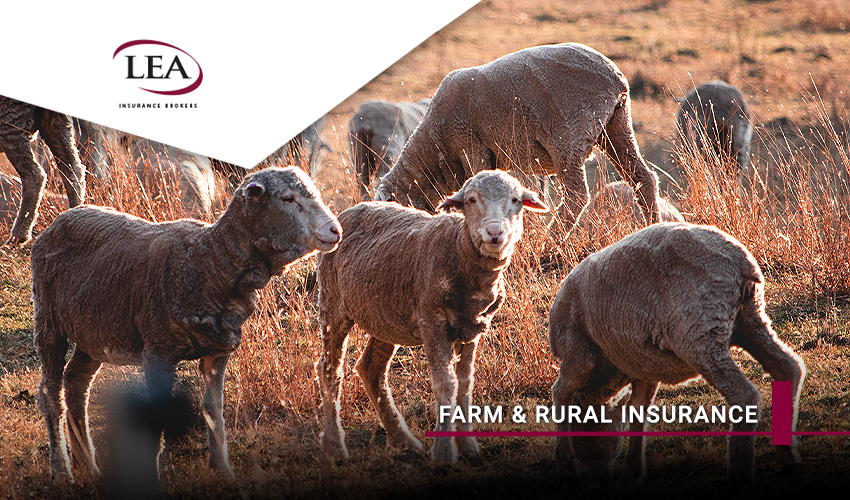
Livelihood on the land: keeping your farming business risk free and financially protected
When it comes to farming there’s probably not a lot you don’t already know. However, when we live and breathe our work, it’s likely that we don’t always take a moment to review how we’re working. After all, who has the time? Which is exactly why we’ve put together this short, easy-to-use guide so you can quickly see where you could fine tune some operations, in order to get a better, more profitable outcome.
So, make a cuppa and sit down. Ten minutes of your time today could change your business forever.
A risky business
Australia is one of the riskiest places to farm thanks to the one threat that affects most components of agriculture – the weather.
Drought can reduce or destroy production. Flood or fire can delay or prevent distribution. Unstable weather conditions pose a danger to staff working on the land and machinery.
All of these risks can culminate in higher insurance premiums, putting a financial strain on the business, which is why it’s so important to seek advice when choosing coverage.
After all, it’s not only the weather that creates risk. Farmers must consider changes in commodity prices, pest, weed and disease conditions, and regulation standards and restrictions.
Many operators are now using Responsive Farm Management. By assessing and judging the conditions, based on previous outcomes and experience, decision makers can better predict what they need to change or adjust in order to thrive.
Machinery and vehicle safety
It’s easy to get complacent when it comes to the equipment you use every day. But the fact is, a high number of injuries on farms could be prevented by ensuring some basic safety rules.
Some easy ways to stay safe around machinery and vehicles include:
- Ensuring all staff are properly trained to use machinery, and training is regularly updated
- Supervising inexperienced workers at all times
- Maintaining and servicing all equipment, as well as fitting and ensuring all safety equipment is operating with the machine at all times
- Storing dangerous machinery in a place where children and untrained persons cannot access
- Arranging an annual First Aid refresher course for all staff
For more information on how to maintain a high level of safety around machines and vehicles, thus reducing risk and costly claims, click here.
Keeping chemicals safe and sound
Chemicals on farms are an everyday necessity, but they can also be extremely dangerous. As well as considering personal safety when handling them, operators need to be aware of the threat to their neighbours, and the environment. A lack of care and operators can face financial burden in the shape of insurance claims, higher premiums and expensive litigation leading to insurance claims and higher premiums.
While choosing chemicals with less toxic properties is preferable, it’s not always possible. Some fuels, insecticides, solvents, fertilisers and more can cause minor to very serious, and even life-threatening, health conditions during exposure. Chemicals can also cause damage depending on how they’re stored, transported and disposed of, which means operators need to be diligent.
Any chemical that poses a health hazard is required to come with a Safety Data Sheet, outlining exactly how it should be used, stored etc, so always follow instructions. Use the personal protective equipment (PPE) listed on the product label and ensure all PPE is in good condition. Pay particular attention to the chemical’s compatibility with other chemicals. Operators can also do a chemical users course (ChemCert).
Predicting and reducing water and climate risks
While it used to be said that you can’t predict the weather, current technologies disagree.
Climate risk management involves trying to predict and get ahead of what is coming, rather than staying vulnerable and dealing with the aftermath once it’s hit.
There are many ways to do this.
Tools such as advanced weather forecasts and climate predictions could go a long way in protecting your business from high costs and loss of profits.
Designing your infrastructure ̶ dams, animal shelters, drip irrigation etc ̶ to better handle extreme conditions, can do the same.
And ensuring you have a risk management strategy in place, in terms of insurance cover, supplier contracts etc, is vital. The right insurance coverage can enable better management of annual financial risks, help protect profits and give farmers a sense of security, so talk to us about the right insurance cover to best meet your needs and requirements.
Livestock handling and reducing risks
Keeping you, your staff, and anyone else who has access to your land, safe with (and from) livestock is a farmer’s responsibility. From properly training staff, to design, provision and maintenance of safe livestock handling plant and structures, to preventing unauthorised access – it’s all down to you.
Assessing where risks could occur, and then limiting those threats, is a good first step. This could be anything from ensuring handlers know how best to approach cattle, to removing or culling a “rogue” livestock who is hard to handle.
Equally, potential hazards relating to paddock, laneway and yard designs, need to be recognised and reduced to help keep both handlers and animals safe.
For a comprehensive guide around cattle handling and safety click here.
Giving operators the best chance of success
Knowledge, training, maintenance and diligence are all essential ingredients in protecting your operations and bottom line. But by selecting the most suitable insurance for you and your business, operators can feel secure in the sense they have added an essential layer of security to their livelihood and risk management plan. Speak to us about how we can help identify the best coverage for you.
